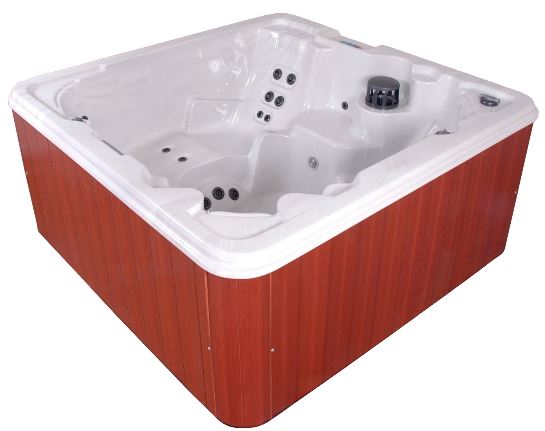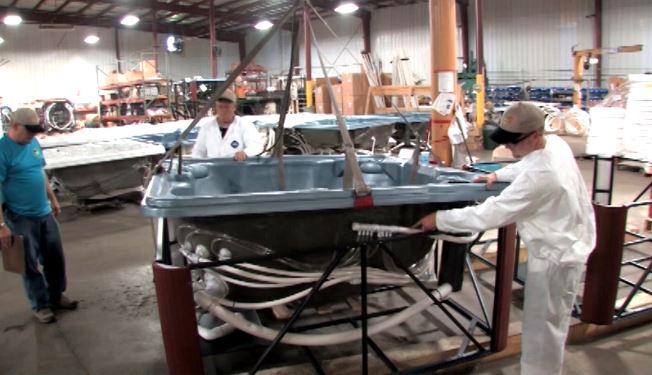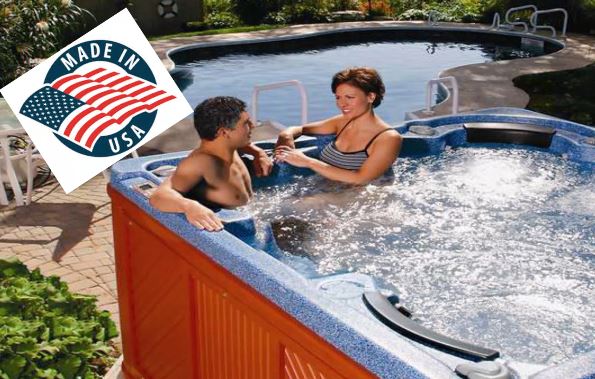 Plug and play 120 volt spas that operate at 110v-120v come with a 15′ GFCI cord already, so they don’t require all of the electrical installation below. Some spas are convertible from 120v to 230v operation, so whenever 220-240v service is needed, the below information will give the reader an idea of what is involved and what their electrician will be dealing with when installing electrical service for a 220 volt hot tub.
Plug and play 120 volt spas that operate at 110v-120v come with a 15′ GFCI cord already, so they don’t require all of the electrical installation below. Some spas are convertible from 120v to 230v operation, so whenever 220-240v service is needed, the below information will give the reader an idea of what is involved and what their electrician will be dealing with when installing electrical service for a 220 volt hot tub.
Most spas will operate with either 50 or 60 amp dedicated service at 220-240 volts. The reason we use 220 volt hookups for hot tubs is mainly to allow a higher wattage heater as well as to all allow for more or higher horsepower pumps, components and functions.
Installing the electrical supply for a 230 volt hot tub involves an electrician integrating the main house panel with a 50 or 60 amp breaker, the external GFCI/disconnects box and the spa pak/hot tub controller box. Be sure that the GFCI should correspond to the house breaker, so for instance a 60A GFCI should be paired with a 60A house breaker. Some spas will require only 50A service while others will require 60A. Some may even operate on split service with a 20A or 30A line. Check the requirements of your electrical hookup for Hot Tubs.
For most exterior spas, the electrician will run the appropriate gauge cable in conduit to the spa location. That involves a run of cable from the main breaker panel to the GFCI shutoff panel and then another run from that “load center” GFCI shutoff panel to the actual hot tub spa pack/controller.
National electrical code and local codes will be different but generally the GFCI shutoff box goes between 5-10 feet from the spa and within the line of sight of the spa. The purpose is to facilitate quick shutoff in an emergency. Even the test button on the GFCI can be used to shutoff power to the spa, but these panels usually come with an external shutoff switch in addition to the GFCI.
The wiring of the GFCI can be tricky depending on if it is 3 wire service or 4 wire service. Most spas that use a 120 volt ozonator or other 110-120v components will require 4-wire GFCi hookup and the passing through of the white/neutral wire to the appropriate lug/connection point on the spa pack or circuit board.
Not all spas operate on 4-wires, and many older spas only had 3 wire service. Never connect a 4-wire hot tub to 3-wire service. Other spa brands such as Hot Springs may require 2 independent lines which would then require 2 separate GFCIs as per their own instructions. Always read the hot tub manufacturer’s manual for details that relate to your spa.
The GFCI is a safety device that can disconnect the power completely if a fault is detected.
Get a weatherproof GFCI/Disconnect box here: Hot Tub GFCI Box
See the article at Hot Tub Outpost about specific types of conduit and other information for electricians.
 The electrician’s installation process includes turning off the power at the main breaker and mounting the hot tub panel 5-10 feet away from the spa, within the line of sight. A conduit trench is dug (being sure to check with local utility company to assure there is no buried cable or pipe there) from the foot of the disconnect box to the spa. Some spas will allow the interior routing of cable once you get to the spa cabinet. Note that it is never permitted to run underground wiring underneath a hot tub. Also avoid placing the spa under any overhead power or communication cables as the electrical code does not allow for any overhead electrical/communications cables within 22 1/2 feet from the top of the water level of the filled spa.
The electrician’s installation process includes turning off the power at the main breaker and mounting the hot tub panel 5-10 feet away from the spa, within the line of sight. A conduit trench is dug (being sure to check with local utility company to assure there is no buried cable or pipe there) from the foot of the disconnect box to the spa. Some spas will allow the interior routing of cable once you get to the spa cabinet. Note that it is never permitted to run underground wiring underneath a hot tub. Also avoid placing the spa under any overhead power or communication cables as the electrical code does not allow for any overhead electrical/communications cables within 22 1/2 feet from the top of the water level of the filled spa.
Hooking up the wire to the spa involves adding the 2 power wires, neutral and ground wires routed through the 1 3/8″ circular hole on the left side of the control box/spa controller (found in many Balboa systems) to the appropriate lugs on the circuit board or routed to the spa pack or controller as per manufacturer’s instructions.
The section(s) of wire that connect the GFCI/disconnect box to the spa must run not only to the hot tub, but to the spa pack located under the cabinet of the spa. Allow a couple of feet of slack to avoid short or stretched wire.
As with any electrical job, it is best to use the services of a licensed electrician to avoid damage to equipment, injury, death. Many municipalities and cities may require a building permit for installing a hot tub outdoors, so check with your city to see if that is the case or not. Electrical inspection will assure your spa is safe before using it.
The cost of installing hot tub wiring can vary from region to region and from electrician to electrician, so it is best to get a few estimates. The wiring can cost several hundred dollars in parts, plus conduit and fittings. The labor can also run $300-$600 or more. The GFCI panel is available at the best price from Hot Tub Outpost.
S ome NEC reference codes for hot tubs: Hot Tubs – NEC Electrical Codes excerpts:
ome NEC reference codes for hot tubs: Hot Tubs – NEC Electrical Codes excerpts:
680.12 and 680.42 A disconnect must be installed within sight of Hot Tub.
680.42 Outdoor Installations
(A) Flexible Connections Listed packaged spa or hot tub equipment assemblies or self-contained spas or hot tubs utilizing a factory-installed or assembled control panel or panelboard shall be permitted to use flexible connections as covered in 680.42(A)(1) and (A)(2).
(1) Flexible Conduit Liquidtight flexible metal conduit or liquidtight flexible nonmetallic conduit shall be permitted in lengths of not more than 1.8 m (6 ft).
680.44 GFCI protection is required for all Hot Tubs and spas.
680.44(A) A Packaged Hot Tub Assembly Unit with a GFCI requires a GFCI Protected Circuit.
There are more codes in article 680 of the National Electrical Code (NEC).
Use of the above content is for information purposes only. There is no warranty for the accuracy of this material and it is best to hire a licensed electrician to install the wiring. Working on any electrical appliance including hot tubs can be very dangerous and should be left to trained service technicians or licensed electricians.
GFCI Tripping?
There are many things that can cause a GFCI to trip, from a faulty GFCI (found by isolating the rest of the spa to see if it still trips), or it can be a spa component such as the heater/heater element, pump, blower, ozonator or other spa component. The culprit can be found by unplugging/isolating the particular component from the system. Sometimes water will get past the check valve of a blower or ozonator and that can cause the GFCI to trip. Remember, the GFCI is there for safety, so the first check should be to narrow down the component causing the short or issue rather than blame the GFCI. It is always recommended to consult a qualified electrician to solve any electrical issues with hot tubs or other appliances.